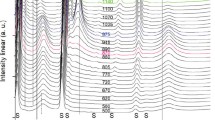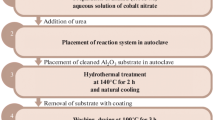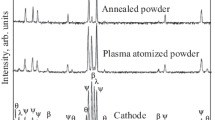Abstract
The synthesis of (Al,Cr)2O3 coatings by PVD frequently results in metastable cubic structures next to the thermodynamically stable and mechanically favourable hexagonal corundum phase. By alloying small amounts of Fe to powder-metallurgically produced Al0.7Cr0.3 targets – used to synthesise (Al,Cr)2O3 films by cathodic arc evaporation – a considerable increase of the hexagonal phase fraction is observed. Detailed transmission electron microscopy studies show that the growth of hexagonal crystallites of a solid solution (Al,Cr,Fe)2O3 can be triggered by small Cr- and Fe-enriched spherical particles, so-called droplets. In contrast, larger spherical or flat-shaped Al-rich droplets induce re-nucleation of undesired cubic film growth. Extending these studies to additional (Al,Cr)2O3 coating systems revealed similar mechanisms, albeit by far less frequent than in the case of Fe-alloyed films. Modifications of the chemical composition of the target by small amounts of dopants may reduce droplet generation and contribute to controlled coating nucleation. Therefore, the cathode surface used is compared with particles, intentionally selected from the plasma stream.
Zusammenfassung
Bei der Synthese von Al2O3 und (Al,Cr)2O3 Schutzschichten mittels physikalischer Dampfphasenabscheidung treten neben der thermisch stabilen hexagonalen Struktur auch metastabile kubische Phasen auf. Durch die thermisch initiierte Umwandung können Rissnetzwerke entstehen und somit zu einer drastischen Reduktion der Schichtfunktionalität führen. Durch gezieltes Hinzulegieren von geringen Mengen an Eisen ist es möglich, die Gefüge-Anteile zugunsten der bevorzugten hexagonalen Phase zu verschieben. In detaillierten Transmissionselektronmikroskopie-Studien wurde dargelegt, dass dieser Entwicklung ein Nukleationsmechanismus an Cr- und Fe-reichen Teilchen (Droplets) zugrunde liegt, die durch selektives Aufschmelzen der Target-Oberfläche entstehen und während des Wachstumsprozesses in die Schicht eingebaut werden. Um den beobachteten Effekt besser zu verstehen und in weiterer Folge zur Steuerung der Synthese gewünschter Schichtstrukturen in Form von Target-Entwicklung zu nutzen, wurden weitreichende Elektronenmikroskopie-Studien am Target-Material und gezielt hergestellten intermetallischen Droplets durchgeführt.
Similar content being viewed by others
Avoid common mistakes on your manuscript.
1 Introduction
Al2O3 and Al-based oxide coatings are potential candidates whenever applications require chemical inertness and outstanding thermo-mechanical properties [1–4]. In particular, the thermodynamically stable corundum or α phase exhibits the most interesting properties of all Al2O3 polymorphs. Low temperature physical vapour deposition (PVD) of Al2O3 films, however, often yields in the formation of a significant volume fraction of amorphous-like and metastable phases [5, 6]. Consequently, these coatings are susceptible to thermally-induced transformation into the stable corundum structure, initiating the formation of crack networks and stresses, which can ultimately lead to failure of the coating. Prevention of multi-phased and cubic-dominated coatings can either be achieved by suitable templates, e.g. Cr2O3 seed-layers [7, 8], or by alloying Cr [9]. These effects base on structural similarities of α‑Al2O3 and α‑Cr2O3. Strong efforts are made to realise the growth of Al-rich single-phased hexagonal (AlxCr1-x)2O3 films as Cr-rich and cubic-structured films are thermally and mechanically inferior [10–12]. The present study represents a summary of investigations focused on the effect of Fe as alloying element on the structural evolution in cathodic arc evaporated (Al,Cr)2O3 films and the role of small incorporated particles as potential nucleation sites for the desired hexagonal structure.
2 Experimental
(Al,Cr)2O3 and (Al,Cr,Fe)2O3 coatings were synthesised in a batch type cathodic arc evaporation system Oerlikon Balzers Innova using powder-metallurgically produced 6‑inch Al0.7Cr0.3 and Al0.675Cr0.275Fe0.05 targets (Plansee Composite Materials GmbH). Details on the substrate preparation, deposition conditions, and investigative methods can be found in [13–15].
3 Results and Discussion
Cross-sectional scanning electron microscopy images with corresponding X‑ray diffraction patterns of Fe-free (Al0.76Cr0.24)2O3) and Fe-alloyed film (Al0.70Cr0.25Fe0.05)2O3) are shown in Fig. 1a and b, respectively. The addition of Fe does not significantly alter growth rate and morphology of the coatings.
Cross-sectional SEM images of (a) (Al0.76Cr0.24)2O3 and (b) (Al0.70Cr0.25Fe0.05)2O3 coatings with corresponding XRD patterns below. Adapted from [13]
A crystallographic analysis by grazing-incidence XRD reveals a mixed composition of metastable cubic (assuming either a γ‑type or B1-like structure) and hexagonal phases for (Al0.76Cr0.24)2O3, whereas the (Al0.70Cr0.25Fe0.05)2O3 coating demonstrates a significant increase of XRD peak intensities indicative for a hexagonal solid solution. A more detailed view on the microstructural changes upon alloying Fe was obtained by TEM studies. The (Al0.76Cr0.24)2O3 coating (Fig. 2a) is dominated by a fine-crystalline cubic structure as implicated by selected area electron diffraction SAED pattern (red solid lines), whereas for (Al0.70Cr0.25Fe0.05)2O3 (Fig. 2b) distinct diffraction spots indicative for larger hexagonal crystallites (blue dashed lines) can be detected next to the less intense cubic diffraction rings.
Cross-sectional TEM photographs with corresponding SAED insets of (a) (Al0.76Cr0.24)2O3 and (b) (Al0.70Cr0.25Fe0.05)2O3 films. Cubic phases are indicated by a solid red lines, hexagonal phases by dashed blue lines. Adapted from [13]
Interestingly, most of the hexagonal crystallites detected exhibit a V‑shaped form and can be traced back to a well-defined isolated origin. A Z‑contrast scanning transmission electron microscopy was used to identify small incorporated metallic particles as nuclei generated at the cathode surface and referred to as droplets. This, in fact, is an interesting observation in the present case as droplets are typically regarded as a major disadvantage of the cathodic arc evaporation process.
An example of droplet-triggered hexagonal growth is shown in Fig. 3. Although the initial growth stage in these coatings is typically governed by cubic structures, several hexagonal crystallites nucleate on small particles and extend through the coating in typical V‑shape (Fig. 3a-c). The SAED acquisition in Fig. 3d stems from an aperture position approximately 50 nm above the particle and proves that, apart from the cubic film matrix, a hexagonal phase is present. According to energy dispersive X‑ray spectroscopy measurements, the particle is Cr- and Fe-enriched, thus slightly depleted in Al as compared to the average target composition. In order to find out whether this is just a coincidence or a systematically occurring mechanism, additional TEM studies were performed. Based on these results, we can conclude that droplet-triggered hexagonal growth occurs also in other Al-Cr-based oxides, although its frequency and intensity strongly depend on the cathode material used. For instance, in Ta-alloyed (Al,Cr)2O3 films (predominantly fine-crystalline cubic-structured) droplets could only occasionally be associated with hexagonal crystallites. From all systems investigated, the Fe-alloyed coatings clearly demonstrated the highest fraction of droplet-triggered growth.
Cross-sectional TEM photographs showing a representative droplet-triggered nucleation of hexagonal crystallites within the (Al0.70Cr0.25Fe0.05)2O3 coating. Adapted from [14]
Apart from these smaller particles, also larger spherical and flat-shaped droplets are incorporated into the coatings [16]. These, however, mostly lead to nucleation of fine-crystalline cubic structures. Fig. 4a shows the occurrence of both droplet types next to each other. The EDS line-scan (Fig. 4b) illustrates that pancake-shaped droplets are typically Al-enriched, whereas the spherical particles exhibit higher Cr and Fe contents. Nonetheless, also larger spherical droplets occasionally act as nuclei for hexagonal crystallites, although only at very selective spots on their surface. We therefore conclude that either local chemical or structural conditions (or a combination of both) are accountable for our observations. Unfortunately, the consistence of droplets embedded in thin TEM lamella leads to difficulties which prevent further detailed investigations on the interface between the droplet surface and the on-growing hexagonal crystallites. According to electron energy loss-spectroscopy, we can conclude that α‑Cr2O3 and Fe2O3 locally formed at the particles give rise for subsequent facilitated hexagonal growth of (Al,Cr,Fe)2O3, similar to the process which was observed for the template supported growth of hexagonal Al2O3 and (Al,Cr)2O3 growth [6–8]. In addition, Zhang et al. [17] studied the formation of a thermally-grown α‑Al2O3 scale on Al8Cr5. However, the conditions for this oxide scale formation are different from the direct PVD oxide synthesis.
a BF TEM micrograph of the main droplet types occurring in CAE (Al,Cr,X)2O3 coatings: spherical and flat-shaped b STEM EDS line-scan from the top to the bottom reveals their significant different chemical composition. Adapted from [14]
Intense droplet-triggered hexagonal growth is observed using Al-Cr-Fe rather than Fe-free Al0.7Cr0.3 cathodes. For this reason, subsequent studies were directed at modifications of the cathode surface as well as macroparticles selected from the plasma stream [15]. The examination of small, i.e. ≤500 nm, droplets is limited by technical restrictions of the FIB preparation, and the studies were therefore focussed on 3‑7 µm droplets. We find that structure and chemistry of these macroparticles correlate with the composition of the target-reaction-zone. In both cases intermetallic Al8Cr5(Fe) phases were identified. Target areas of a distinct inhomogeneous structure with significant amounts of variously-sized Fe- and Cr- particles are only existent in form of oxide islands which are usually not evaporated by the cathodic arc.
Post-deposition isothermal oxidation studies (not shown here) indicate that a slight difference in the initial oxidation behaviour is given between Al8Cr5 and Al8(Cr,Fe)5 droplets. To correlate these finding with our observations of droplet-triggered growth within cathodic arc evaporated (Al,Cr)2O3 and (Al,Cr,Fe)2O3 films, additional TEM studies covering a larger chemical variety and extended oxidation treatments are necessary.
4 Conclusions
(Al,Cr)2O3 and (Al,Cr,Fe)2O3 coatings were synthesised in an industrial-scaled batch type coating system by cathodic arc evaporation. Fe-doping of the coatings up to 5 at.% results in a significant shift of the multi-phase structural composition towards a higher hexagonal phase fraction. Detailed transmission electron microscopy studies revealed that, frequently, small (≤150 nm) spherical Cr- and Fe-enriched particles act as nuclei for the α‑(Al,Cr,Fe)2O3 solid solution. The identification of the preconditions needed for the local hexagonal growth in Al-rich coatings will support the design of targets and the coating synthesis.
References
Åstrand, M.; Selinder, T. I.; Fietzke, F.; Klostermann, H.: PVD-Al2O3-coated cemented carbide cutting tools, Surface and Coatings Technology, 188-189 (2004), pp 186–192
Bobzin, K.; Bagcivan, N.; Reinholdt, A.; Ewering, M.:Thermal stability of γ‑Al2O3 coatings for challenging cutting operations, Surface and Coatings Technology, 205 (2010), pp 1444–1448
Prengel, H. G.; Heinrich, W.; Roder, G.; Wendt, K. H.: CVD coatings based on medium temperature CVD κ‑ and α‑Al2O3, Surface and Coatings Technology, 68-69 (1994), pp 217–220
Halvarsson, M.; Vuorinen, S.: Microstructure and performance of CVD κ‑Al2O3 multilayers, Materials Science and Engineering: A, 209 (1996), pp 337–344
Levin, I.; Brandon, D.: Metastable Alumina Polymorphs: Crystal Structures and Transition Sequences, Journal of the American Ceramic Society, 81 (2005), pp 1995–2012
Kohara, T.; Tamagaki, H.; Ikari, Y.; Fujii, H.: Deposition of α‑Al2O3 hard coatings by reactive magnetron sputtering, Surface and Coatings Technology, 185 (2004), pp 166–171
Eklund, P.; Sridharan, M.; Sillassen, M.; Bøttiger, J.: α‑Cr2O3 template-texture effect on α‑Al2O3 thin-film growth, Thin Solid Films, 516 (2008), pp 7447–7450
Pohler, M.; Franz, R.; Ramm, J.; Polcik, P.; Mitterer, C.: Seed layer stimulated growth of crystalline high Al containing (Al,Cr)2O3 coatings deposited by cathodic arc evaporation, Thin Solid Films, 550 (2014), pp 95–104
Ramm, J.; Ante, M.; Bachmann, T.; Widrig, B.; Brändle, H.; Döbeli, M.: Pulse enhanced electron emission (P3eTM) arc evaporation and the synthesis of wear resistant Al–Cr–O coatings in corundum structure, Surface and Coatings Technology, 202 (2007), pp 876–883
Khatibi, A.; Palisaitis, J.; Höglund, C.; Eriksson, A.; Persson, P. O. Å.; Jensen, J.;Birch, J.; Eklund, P.; Hultman, L.: Face-centered cubic (Al1−xCrx)2O3, Thin Solid Films, 519 (2011), pp 2426–2429
Khatibi, A.; Lu, J.; Jensen, J.; Eklund, P.; Hultman,L.: Phase transformations in face centered cubic (Al0.32Cr0.68)2O3 thin films, Surface and Coatings Technology, 206 (2012), pp 3216–3222
Najafi, H.; Karimi, A.; Dessarzin, P.; Morstein, M.: Formation of cubic structured (Al1-xCrx)2+δO3 and its dynamic transition to corundum phase during cathodic arc evaporation, Surface and Coatings Technology, 214 (2013), pp 46–52
Koller, C. M.; Ramm, J.; Kolozsvári, S.; Munnik, F.; Paulitsch, J.; Mayrhofer, P. H.: Corundum-type Fe-doped cathodic arc evaporated Al–Cr–O coatings, Scripta Materialia, 97 (2015), pp 49–52
Koller, C. M.; Ramm, J.; Kolozsvári, S.; Paulitsch, J.; Mayrhofer, P. H.: Role of droplets and iron on the phase formation of arc evaporated Al–Cr-oxide coatings, Surface and Coatings Technology, 276 (2015), pp 735–742
Koller, C. M.; Hahn, R.; Ramm, J.; Kolozsvári, S.; Mayrhofer, P. H.: Microstructural modifications in powder-metallurgically produced Al0.675Cr0.275Fe0.05 targets during cathodic arc evaporation, Journal of Vacuum Science and Technology: A, 34 (2016), p 021603
Pohler, M.; Franz, R.; Ramm, J.; Polcik, P.; Mitterer, C.: Cathodic arc deposition of (Al,Cr)2O3: Macroparticles and cathode surface modifications, Surface and Coatings Technology, 206 (2011), pp 1454–1460
Zhang, M.; Xu, B.; Ling, G.: Preparation and characterization of α‑Al2O3 film by low temperature thermal oxidation of Al8Cr5 coating, Applied Surface Science, 331 (2015), pp 1–7
Acknowledgements
The financial support of Plansee Composite Materials GmbH and Oerlikon Balzers, Oerlikon Surface Solutions AG is gratefully acknowledged. We also thank for the support by the X‑Ray Center of the Vienna University of Technology Austria as well as the University Service Centre for Transmission Electron Microscopy, TU Wien, Austria.
Author information
Authors and Affiliations
Corresponding author
Rights and permissions
Open Access This article is distributed under the terms of the Creative Commons Attribution 4.0 International License (http://creativecommons.org/licenses/by/4.0/), which permits unrestricted use, distribution, and reproduction in any medium, provided you give appropriate credit to the original author(s) and the source, provide a link to the Creative Commons license, and indicate if changes were made.
About this article
Cite this article
Koller, C.M., Hahn, R., Widrig, B. et al. Triggering the Phase Evolution Within (Al,Cr)2O3-based Coatings by Alloying and Microstructural Concepts. Berg Huettenmaenn Monatsh 161, 325–329 (2016). https://doi.org/10.1007/s00501-016-0506-2
Received:
Accepted:
Published:
Issue Date:
DOI: https://doi.org/10.1007/s00501-016-0506-2








